柑橘肥水智能决策支持系统的变化预测方法及应用效果
2017-09-15西南大学计算机与信息科学学院重庆400715
王 艺,王 英(西南大学计算机与信息科学学院,重庆 400715)
柑橘肥水智能决策支持系统的变化预测方法及应用效果
王 艺,王 英
(西南大学计算机与信息科学学院,重庆 400715)
本体是农业智能信息系统的核心,是实现精准农业信息服务的关键。本体的维护和管理过程将导致本体发生各种变化,从而对其支撑的应用程序产生不同程度的影响。如何有效地分析本体元素的变化对应用程序的影响是农业智能信息系统维护和管理的难题。该文提出一种基于界面组件依赖矩阵、本体概念依赖矩阵及本体概念-界面组件依赖矩阵的系统变化预测方法,实现了避免代码层分析而较准确预测本体概念的变化对应用程序用户界面组件的影响。以包含22个本体概念和6个界面组件的柑橘肥水智能决策支持系统为案例分析,验证结果表明:该变化预测方法能够达到85%的平均准确率和98%的平均召回率。该变化预测方法对解决以本体为核心的农业智能信息系统的变化管理难题可提供有效的解决方案。
系统分析;软件结构;预测;语义本体;本体变化管理;柑橘肥水决策支持系统;软件变化管理
0 引 言
智能农业信息系统以高质量的领域本体为核心,以期实现精准及个性化的农业决策支持服务[1-8]。在开发此类系统时,由于农业领域知识具有海量和多源的特点,本体的开发一般以决策支持任务为目标,进行相关部分本体的构建,而不是完成全部本体再进行应用程序开发工作[9-13]。针对不同应用领域的农业本体构建工作取得一定进展[4,14-20],包括标准词汇如AGROVOC[14]和NAL农业术语集[15],柑橘肥水本体[4]、土豆本体[16]、大米本体[17]、农产品冷链管理体系本体[18]、水质本体[19]及玉米病虫害本体[20]。当本体变化时,例如本体元素的删除或者增加,本体所支撑的应用程序,将会受到不同程度的影响,甚至导致应用程序的功能失效[21-24]。因此,以本体为核心的农业信息系统需要解决:当本体元素有变化时,如何预测并获取其支撑的应用程序功能受到的影响情况。
现有相关研究主要集中于本体进化管理[21-24],以及软件系统的变化管理[25-32],而缺乏针对基于本体的智能决策系统的变化管理的研究,因而无法解决本体变化所导致的应用程序的变化影响分析和预测问题。
本文提出一种本体概念的变化对应用程序界面组件影响的预测方法,以期为智能农业信息系统的变化管理难题提供可行的解决方法,并以柑橘肥水智能决策支持系统[4]为案例进行验证。
1 柑橘肥水智能决策支持系统变化管理
如图1所示,基于本体的柑橘肥水智能决策支持系统由柑橘肥水本体、基于本体的应用程序以及界面组件构成。本体包含了施肥和排灌专家知识,是决策支持系统的核心。本体由概念、实例和属性组成。实例是概念所包含的成员,属性体现实例间的关系。基于柑橘本体的应用及程序可基于各类平台,如Web应用、安卓手机应用等,进行访问。界面组件包含文本框和下拉菜单等常用界面元素,它体现了应用程序的功能,实现应用程序与用户的交互[4,28]。
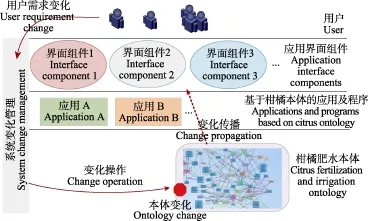
图1 柑橘肥水智能决策支持系统及其变化管理Fig.1 Citrus fertilization and irrigation intelligent decision support system and its change management
由于系统维护以及用户需求变化等,本体会不断进行修改和扩展[23-24]。当本体有变化时,构建在本体之上的应用程序将受到不同程度的影响。直观地说,用户交互界面组件可能发生改变,例如:增加了用户输入信息的要求或者删除某个下拉菜单选项等。本文的方法是基于本体概念和界面组件在概念层的直接关联矩阵,构建变化影响传播树,计算本体概念的变化预测值,实现本体概念变化对用户界面组件的预测。
2 基于依赖矩阵及变化影响传播树的变化预测方法
设集合C={c1, …, cn}包含本体的所有与领域直接相关的概念,不考虑通用的概念如owl:Thing等。集合IC= {ic1, …, icm}包含应用程序的所有组件。集合V=, …, v包含所有界面变量。令V(ic)⊆V,表示组件ic关联的界面变量集合。对界面组件依赖矩阵、本体概念依赖矩阵、本体概念-界面组件依赖矩阵和变化影响传播树进行定义和说明如下。
2.1 依赖矩阵定义
2.1.1 界面组件依赖矩阵
界面组件依赖矩阵Mic=(ωij)m×m,是m阶矩阵,表示组件ici依赖于组件icj的程度,ωij介于0~1之间

式中|V(ici) ∩V(icj)|表示ici和icj共同的界面变量的个数,|V(ici) ∪V(icj)|表示ici和icj包含的所有界面变量的个数。
界面组件依赖矩阵Mic通过界面组件间共同的界面变量在概念层建立了界面组件间的关联[28]。这里,概念层是指应用程序的设计和用户界面层,它是相对于程序源代码层而言。

2.1.2 本体概念依赖矩阵
本体概念依赖矩阵Mc=(rij)n×n,是n阶矩阵,rij介于0~1之间,表示本体概念ci依赖cj的程度。设在本体中ci与包含cj的共K<n个概念通过本体属性有关联,则

本体概念依赖矩阵描述本体概念间的相互关联度。Mc元素rij的计算采用依赖图算法[29]。
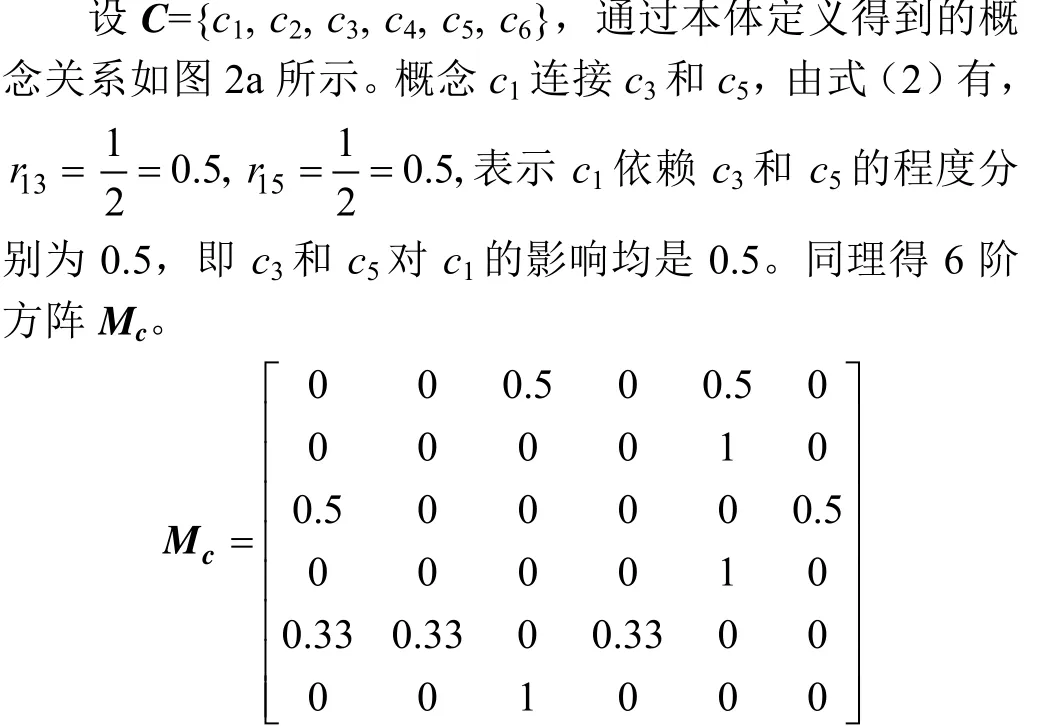
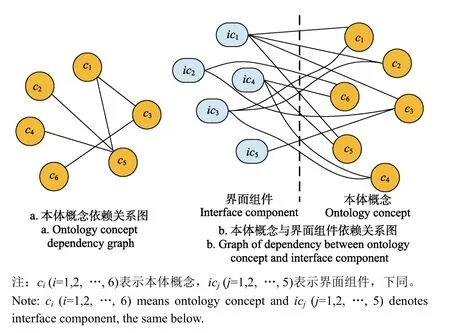
图2 本体概念及与界面组件间的依赖关系图Fig.2 Ontology concept dependency and dependency between ontology concept and interface component
2.1.3 本体概念-界面组件依赖矩阵
本体概念-界面组件依赖矩阵Mc->ic=(dij)m×n,dij介于0~1之间,表示概念cj对组件ici的影响程度。设ici同时关联于包含cj的R<n个概念,则

本体概念-界面组件依赖矩阵描述了本体概念对界面组件在概念层的直接关联。

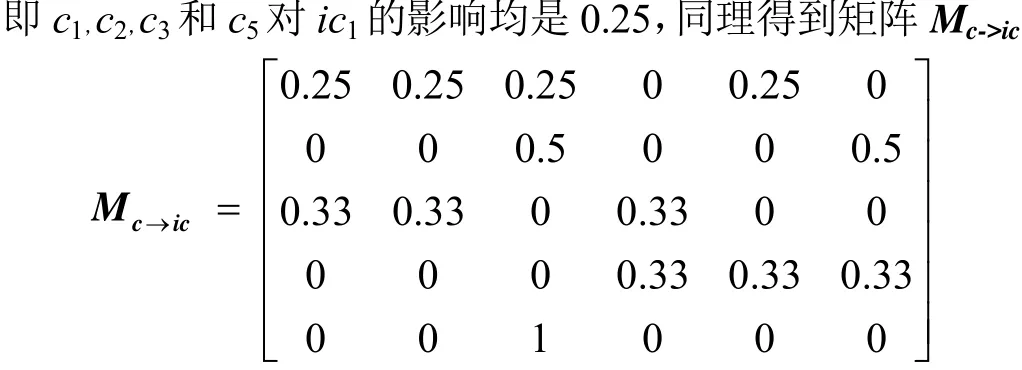
2.2 变化影响传播树
2.2.1 变化影响传播树定义及算法
变化影响传播树T=(X, Z)是一棵树,其根节点是r∈C, r为发生初始变化的本体概念,节点集合X由IC和C中所有元素构成,边集合Z=(vi,vj),vi, vj∈X,表示vi对vj有影响。从根节点r到任何叶节点的路径p=r…vt,不允许有重复的节点出现。算法1是构建以本体概念cs为根的变化影响传播树的方法,其中threshold是树高阈值,h是表示树高的变量。
算法1


2.2.2 变化影响传播树的构建过程
给定Mic,Mc及Mc->ic,图3是概念c1的变化影响传播树且树高阈值threshold为3。变化影响树的树根为c1,即X0={c1}。检索Mic,Mc及Mc->ic知c1对ic1, ic3, c3, c5均有影响,得到X1={ic1, ic3, c3, c5},即如图3所示的树高度为1的所有节点。对X1中的所有节点,检索Mic,Mc及Mc->ic,找出相应的影响节点,并排除从根节点到所有节点的路径上有重复节点的情况。以ic1为例,由Mic知,ic1影响ic2, ic4, ic5, 得到图3所示ic1的3个子节点。以此类推,得到X2={ ic1, ic2, ic4, ic5, c2, c4, c6},如图3所示的树高度为2的所有节点。同理可得树高度为3的所有节点集合X3。

图3 概念c1的变化影响传播树及概念c1对ic2的变化影响路径Fig.3 Change impact propagation tree for concept c1and change impact paths from c1to ic2
2.2.3 变化预测值的计算方法
根据界面组件依赖矩阵Mic、本体概念依赖矩阵Mc及本体概念-界面组件依赖矩阵Mc->ic所描述的元素间直接关联所构建的变化影响传播树,反映了本体概念对界面组件的综合影响情况。为量化本体概念对界面组件的综合影响程度,本文提出如下方法计算该综合影响程度,并将量化的综合影
响程度称为变化预测值。变化预测值的计算方法是:将变化影响传播树看作逻辑树,即树的同一条路径的节点看作“与”(and),而分支节点看作“或”(or)运算[30],根据逻辑树的“与”和“或”计算式(4)(5)所示,可获取本体概念对界面组件的变化预测值。

其中vivjvk是一条路径,evi→vj和evj→vk分别是vi对vj的变化预测值(表示vi的变化对vj产生影响的程度,其值介于0~1之间)和vj对vk的变化预测值(表示vj的变化对vk产生影响的程度,其值介于0~1之间)。若vi(vj)对vj(vk)有直接影响,其数值分别由矩阵Mic,Mc和Mc->ic的相应元素ωij、γij和dij给出。

其中vivj和vivk是变化影响传播树的2条路径,vi是分支节点。
图3中c1到ic2有8条间接影响路径(图3所示圆圈标示),分别通过4个节点ic1、ic3、c3和c5传播变化影响,故c1对ic2的变化预测值可依据式(4)、式(5)计算所得为0.52。
故当c1改变时,导致界面组件ic2发生变化的可能性为52%。
2.2.4 变化影响传播树的高度限制
变化影响传播树的树高用变量threshold进行了限制,其原因是:首先,当节点数量较大时,变化影响传播树从根至叶节点的路径会很长,数据处理的时间复杂度呈路径长度的指数增长[30]。语义本体的概念数量通常较大(例如AGROVOC[14]本体有32 000个概念),因此必须限定树高以控制计算复杂度。其次,由式(4)知,路径越长,概念对组件的间接影响值会减弱较快。故限定树的高度以控制计算复杂度并获得满意的预测结果是合理且相关研究推荐策略,一般建议树高为3[30]。
3 案例分析及方法验证
本文以柑橘肥水智能决策支持系统[4]对所提变化预测方法进行验证。验证方法是对本体概念的变化,根据所提变化预测方法计算得到界面组件的变化预测值,通过与变化预测阈值比较,得到预测所有影响的界面组件,将其与系统组件变化的实际结果比较,以评价所提预测方法的有效性。系统变化的实际结果通过直接分析柑橘肥水智能决策支持系统的源代码得到。
柑橘肥水智能决策支持系统[4]有3个子系统:施肥查询、病症查询及排灌监测,其界面组件共6个:按果园查询(ic1),初次查询(ic2),施肥建议(ic3),选择病症(ic4),查询结果(ic5),监控主页(ic6),共关联30个系统变量,得到界面组件依赖矩阵Mic。
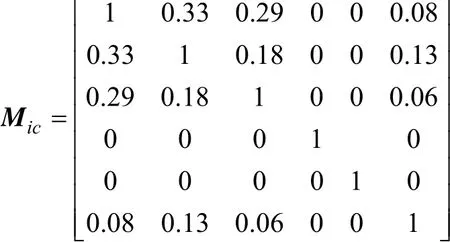
柑橘肥水本体[4]共22个领域概念,根据其本体概念依赖关系图,得到相应的本体概念依赖矩阵Mc。

最后得到柑橘肥水决策系统的本体概念-界面组件依赖矩阵Mc->ic

表1是通过构建变化影响传播树,并根据变化预测值的计算方法得到的22个概念对6个界面组件的变化预测值,以表示本体概念的变化对界面组件的综合影响程度。
为验证变化影响预测的准确性,对柑橘肥水智能决策支持系统[4]JSP/Servlet源码进行人工分析,得到本体概念变化对界面组件影响的实际结果(如表2所示)。为从表1获取本体概念对界面组件的变化预测结果,以便与实际结果比较,本文采用设定变化预测阈值λ的方法。变化预测阈值λ介于0%~100%之间,是变化预测值有效的最低值,即:当概念对界面组件的变化预测值大于等于λ时,则判断概念的变化对界面组件有影响;否则概念的变化对界面组件没有影响。以概念c1为例,当变化预测阈值λ为5%时,由表1知c1对ic3, ic4和ic5的变化预测值均大于λ,故c1变化会影响ic3, ic4和ic5,即c1的变化预测结果为{ic3, ic4, ic5}。表2是根据表1的数据分别取变化预测阈值λ1=5%和λ2=10%所得到的界面组件的预测结果。
本文采用广泛应用于统计学和信息检索领域的2个度量值准确率和召回率(见式(6)、(7)),用于评价方法的有效性。P是变化影响预测结果集合,E是源代码分析结果,p是预测的准确率,r是预测的召回率。注意到,当E为空集时,r为1。若E和P同时为空集,p为1。这里,准确率p表示预测结果集合P中,有多少组件是真正的受到变化影响的。召回率r表示有多少实际组件集合E中的元素被正确预测到。以表2中c22为例,当λ1=5%时,P={ic3,ic4, ic5},E={ic4, ic5},由式(6)得p为0.67,由式(7)得r为1,说明该方法能正确预测67%的组件,且100%预测到受影响的组件。一般情况下,准确率和召回率是冲突的,即高准确率会导致低召回率,反之,高召回率可能导致低准确率。表2给出了变化预测阈值λ1=5%和λ2=10%的相应准确率和召回率。试验结果表明,当设定较小的变化预测阈值时可以得到较高的召回率,而准确率有所下降;反之,当设定较大的变化预测阈值时,则可以得到较高的准确率,但召回率就有所下降。式(8)、(9)是平均准确率和平均召回率,用于评价22个本体概念的平均预测结果。其中pi表示ci的准确率,ri是召回率,n是概念总数。
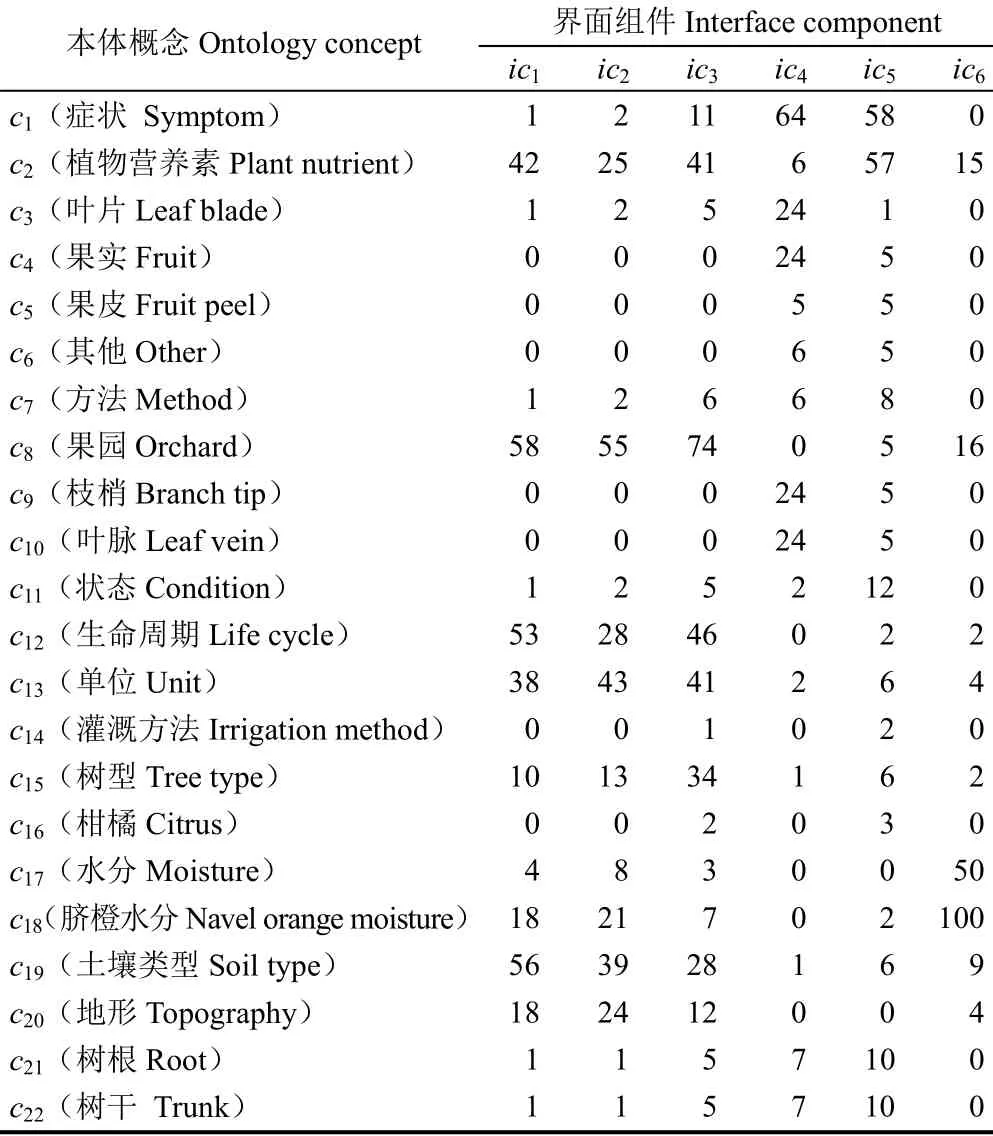
表1 本体概念对界面组件的变化预测值Table 1 Change prediction values for interface components relating to ontology concepts %

表2 本体概念对界面组件变化预测结果及其准确率和召回率分析Table 2 Change prediction results for interface components relating to ontology concepts and analysis of precision and recall rates
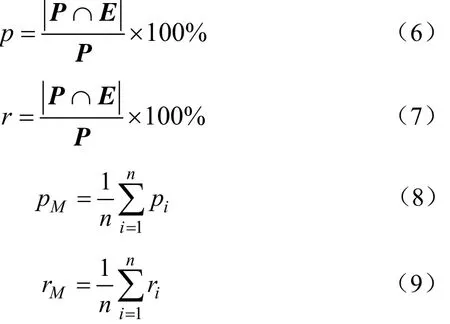
准确率p和召回率r在不同应用领域和需求有不同的参考范围[28,31-34]。在软件系统管理领域,准确率高于40%而召回率高于60%,可以证明方法的有效性[28,31-32];在知识提取领域[33-34],准确率高于60%,而召回率高于40%,可以证明方法的有效性。表2的验证结果显示,当变化预测阈值取5%时,22个概念的预测平均准确率为77%,平均召回率为98%;当变化预测阈值取10%时,22个本体概念的预测平均准确率为85%,平均召回率为74%,证明该方法的有效性。当把预测结果的阈值从5%提高到10%时,精确率由77%提升到85%,而召回率由98%下降到74%。阈值5%和10%是根据参考文献[28,30]及笔者试验所取的经验值,可以根据实际需要在此基础上调整。
4 结 论
本文针对在基于语义本体的农业决策支持系统中,分析和管理本体概念变化对应用程序界面组件的综合变化影响难题,提出了基于界面组件依赖矩阵、本体概念依赖矩阵、本体概念-界面组件依赖矩阵及变化影响传播树的变化影响分析和预测方法。本文以柑橘肥水智能决策支持系统为案例研究对象,验证了所提出的系统变化预测方法的有效性,主要有以下结论:
1)对柑橘肥水本体的22个本体概念,6个界面组件,在不需要查看系统源代码的情况下,仅根据概念层的直观依赖关系,能够达到85%的平均准确率和98%的平均召回率,证明了所提方法的有效性。
2)在软件系统变化管理领域,该方法的准确率和召回率能够满足应用需求,可大幅度降低本体变化影响分析的人工成本,提高智能决策支持系统的管理效率。试验结果说明,当期望较高准确率时,应设定较大的变化预测阈值;当期望较高召回率时,应设定较小的变化预测阈值。
3)本文针对基于语义本体的柑橘肥水智能决策支持系统所提出的变化预测方法能够应用到其他智能信息系统,可用于预测本体元素的变化对系统其他组件的影响情况。
[1] 陈立平,赵春江,刘学馨,等. 精确农业智能决策支持平台的设计与实现[J]. 农业工程学报,2002,18(2):145-148. Chen Liping, Zhao Chunjiang, Liu Xuexin,et al. Design and implementation of intelligent decision support system for precision agriculture [J]. Transactions of the Chinese Society of Agricultural Engineering (Transactions of the CSAE), 2002, 18(2): 145-148. (in Chinese with English abstract)
[2] Beck H, Morgan K, Jung Y, et al. Ontology-based simulation in agricultural systems modeling[J]. Agricultural Systems, 2010, 103(7): 463-477.
[3] Nikkilä R, Seilonen I, Koskinen K. Software architecture for farm management information systems in precision agriculture[J]. Computers and Electronics in Agriculture, 2010, 70(2): 328-336.
[4] 王艺,王英,原野,等. 基于语义本体的柑橘肥水管理决策支持系统 [J]. 农业工程学报,2014,30(9):93-101. Wang Yi, Wang Ying, Yuan Ye, et al. A decision support system for fertilization and irrigation management of citrus based on semantic ontology[J]. Transactions of the Chinese Society of Agricultural Engineering (Transactions of the CSAE), 2014, 30(9): 93-101. (in Chinese with English abstract)
[5] Xu Liyuan, Chen Liping, Chen Tianen, et al. SOA-based precision irrigation decision support system[J]. Mathematical and Computer Modelling, 2011, 54(3): 944-949.
[6] 陈叶旺,李海波,余金山. 一种基于农业领域本体的语义检索模型[J]. 华侨大学学报:自然学科版,2012,33(1):27-32. Chen Yewang, Li Haibo, Yu Jinshan. A semantic retrieval model based on agricultural field ontology [J]. Journal of Huaqiao University: Natural Science, 2012, 33(1): 27-32. (in Chinese with English abstract)
[7] 孙想,吴华瑞,朱华吉,等. 基于语义Web的农业生产协同决策服务机制研究[J]. 农机化研究,2011(3):34-38. Sun Xiang, Wu Huarui, Zhu Huaji, et al. Research on the mechanism of agricultural collaborative decision making service based on semantic web[J]. Journal of Agricultural Mechanization Research, 2011(3): 34-38. (in Chinese with English abstract)
[8] Ginige A, De Silva L, Ginige T, et al. Towards an agriculture knowledge ecosystem: a social life network for farmers in Sri Lanka[C]//9th Conference of the Asian Federation for Information Technology in Agriculture (AFITA 2014): ICT’s for Future Economic and Sustainable Agricultural Systems, Perth, Australia. 2014: 170-179.
[9] Allemang D, Hendler J. Semantic web for the working ontologist: effective modeling in RDFS and OWL[M]. Burlington: Morgan Kaufmann Publishers, 2011.
[10] Noy N F. Semantic integration: a survey of ontology- basedapproaches [J]. ACM Sigmod Record, 2004, 33(4): 65-70.
[11] Křemen P, Kouba Z. Ontology-driven information system design[J]. IEEE Transactions on Systems, Man, and Cybernetics, Part C (Applications and Reviews), 2012, 42(3): 334-344.
[12] Amarger F, Chanet J P, Haemmerlé O, et al. Skos sources transformations for ontology engineering: Agronomical taxonomy use case[C]//Research Conference on Metadata and Semantics Research. Springer International Publishing, 2014: 314-328.
[13] Wang H, Tudorache T, Dou D, et al. Analysis of user editing patterns in ontology development projects[C]//OTM Confederated International Conferences, On the Move to Meaningful Internet Systems. Springer Berlin Heidelberg, 2013: 470-487.
[14] AGROVOC Multilingual agricultural thesaurus[Z]. http:// aims.fao.org/vest-registry/vocabularies/agrovoc-multilingualagricultural-thesaurus.
[15] The national agricultural library's agricultural thesaurus[Z]. http://agclass.nal.usda.gov/agt.shtml.
[16] Haverkort A J, Top J L. The potato ontology: Delimitation of the domain, modelling concepts, and prospects of performance[J]. Potato Research, 2011, 54(2): 119-136.
[17] Thunkijjanukij A. Ontology development for agricultural research knowledge management: A case study for Thai rice[D]. Bangkok: Kasetsart University, 2009.
[18] 牟向伟,陈燕,曹妍. 农产品冷链HACCP管理体系知识建模与推理[J]. 农业工程学报,2016,32(2):300-308. Mou Xiangwei, Chen Yan, Cao Yan. HACCP knowledge modeling and reasoning for agricultural products cold-chain logistics[J]. Transactions of the Chinese Society of Agricultural Engineering (Transactions of the CSAE), 2016, 32(2): 300-308. (in Chinese with English abstract)
[19] Jajaga E, Ahmedi L, Ahmedi F. An expert system for water quality monitoring based on ontology[C]//Research Conference on Metadata and Semantics Research. Springer International Publishing, 2015: 89-100.
[20] 张伶子,段青玲,李道亮. 玉米病虫害诊治本体构建技术研究[J]. 农机化研究,2012(1):41-45. Zhang Lingzi, Duan Qingling, Li Daoliang. Study on ontology construction of diagnostic of corn’s disease[J]. Journal of Agricultural Mechanization Research, 2012(1): 41 -45. (in Chinese with English abstract)
[21] Falconer S, Tudorache T, Noy N F. An analysis of collaborative patterns in large-scale ontology development projects[C]//Proceedings of the sixth international conference on Knowledge capture. ACM, 2011: 25-32.
[22] Touhami R, Buche P, Dibie J, et al. Ontology evolution for experimental data in food[C]//Research Conference on Metadata and Semantics Research. Springer International Publishing, 2015: 393-404.
[23] Flouris G, Manakanatas D, Kondylakis H, et al. Ontology change: Classification and survey[J].The Knowledge Engineering Review, 2008, 23(2): 117-152.
[24] Khattak A M, Latif K, Lee S. Change management in evolving web ontologies[J]. Knowledge-Based Systems, 2013, 37: 1-18.
[25] Buckley J, Mens T, Zenger M, et al. Towards a taxonomy of software change[J]. Journal of Sotware Maitenance and Evolution: Research and Practice, 2005, 17(5): 309-332.
[26] Mohan K, Xu P, Cao L, et al. Improving change management in software development: Integrating traceability and software configuration management[J]. Decision Support Systems, 2008, 45(4): 922-936.
[27] Bhattacharya P, Iliofotou M, Neamtiu I, et al. Graph-based analysis and prediction for software evolution[C]//Software Engineering (ICSE), 2012 34th International Conference on. IEEE, 2012: 419-429.
[28] Aryani A, Peak I D, Hamilton M. Domain-based change propagation analysis: An enterprise system case study [C]//Proceedings of the 2010 IEEE International Conference on Software Maintenance, Romania, IEEE Computer Society, 2010: 1-9.
[29] Stuckenschmidt H, Schlicht A. Structure-based partitioning of large ontologies[C]//In Modular Ontologies, Springer Berlin Heidelberg, 2009:187-210.
[30] Clarkson P J, Simons C, Eckert C. Predicting change propagation in complex design[J]. Journal of Mechanical Design, 2004, 126(5), 788-797.
[31] Treude C, Robillard M P, Dagenais B. Extracting development tasks to navigate software documentation[J]. IEEE Transactions on Software Engineering, 2015, 41(6): 565-581.
[32] Choetkiertikul M, Dam H K, Tran T, et al. Predicting delays in software projects using networked classification[C]//2015 30th IEEE/ACM International Conference on Automated Software Engineering (ASE), IEEE, 2015: 353-364.
[33] Corcoglioniti F, Rospocher M, Aprosio A P. A 2-phase frame-based knowledge extraction framework[C]// Proceedings of the 31st Annual ACM Symposium on Applied Computing. ACM, 2016: 354-361.
[34] Mukherjee S, Ajmera J, Joshi S. Domain cartridge: Unsupervised framework for shallow domain ontology construction from corpus[C]//Proceedings of the 23rd ACM International Conference on Conference on Information and Knowledge Management. ACM, 2014: 929-938.
Change prediction approach and application effect for citrus fertilization and irrigation intelligent decision support system
Wang Yi, Wang Ying
(School of Computer and Information Science, Southwest University, Chongqing 400715, China)
Agricultural information systems rely heavily on ontologies to realize intelligent and precision agricultural information services such as disease diagnosis and crop planting management. In the development of agricultural applications, due to the massive and cross domain knowledge required in the agricultural domain, it is impossible to develop applications after the completion of domain ontologies. Due to various reasons, ontologies are constantly modified, augmented, or evolved during the application development. Since ontologies are often tightly interwoven with applications, when changes occur in ontologies, the applications such as query services and decision support services that rely on them will be affected in different ways and may not function correctly. Therefore, it is important to provide mechanisms that fill the gap between ontology evolution management and the change management of knowledge based systems. In this paper, we proposed an approach to analyze and predict change impacts on user interface components when the underlying ontology is changed of its concepts. Our approach avoided the hard and error-prone task to analyze change impacts at the lower level, i.e., source code level. Instead, in our method, the change impact prediction was accomplished at the higher conceptual level. Specifically, we focused on the problem that when ontology concepts were changed, how to determine the affected user interface components of applications without diving into the source codes of the system. Our approach was based on constructing three matrices: the interface component dependency matrix, the ontology concept dependency matrix, and the ontology concept-user interface component correlation matrix, at the conceptual level. The interface component dependency matrix specified the direct reliance between interface components based on the shared interface variables of interface components. The ontology concept dependency matrix described the direct relationships between ontology concepts derived from domain ontology. The ontology concept-user interface component correlation matrix specified the direct dependencies between concepts and interface components. With the three matrices, we provided an algorithm to create the change impact propagation tree for each involved ontology concept. By treating the change impact propagation tree as a logical tree, we were able to calculate the change impact prediction probabilities for each concept and interface component. By setting appropriate prediction thresholds, we can obtain the predicted change impact results. To evaluate our approach of change prediction for interface components relating to ontology concepts, we applied the proposed method to the citrus fertilization and irrigation intelligent decision support system. The citrus decision support system was supported by a citrus fertilization and irrigation ontology, which contained 22 domain concepts. The decision support system had six user interface components. For each of the 22 concepts, we calculated the change impact probabilities for each of the six interface components by the change impact propagation trees. In addition, we obtained the actual data by analyzing the Java source codes of the citrus decision support systems. In order to compare the experiment data with the actual data, we set two empirical prediction thresholds, 5% and 10%, based on the existing related studies for filtering the experiment data. We applied two traditional statistic indicators, precision and recall, to evaluate the results. The final evaluation results showed that given the prediction threshold of 5%, the average precision of change impact prediction for the 22 concepts was 77% and the average recall was 98%. Given the threshold of 10%, the average precision of change impact prediction for the 22 concepts reached 85% and the average recall was 74%. There was a tradeoff between precision and recall, i.e., a higher precision indicated a lower recall. In our cases, the precision and recall rates for the both thresholds indicated satisfied results for our proposed change impact prediction approach. The proposed approach provides a feasible and effective solution to the challenging task of change management problem in agricultural information systems based on ontologies.
systems analysis; software architecture; prediction; semantic ontology; ontology change management; citrus fertilization and irrigation decision support system; software change management
10.11975/j.issn.1002-6819.2017.16.023
S126
A
1002-6819(2017)-16-0174-08
王 艺,王 英. 柑橘肥水智能决策支持系统的变化预测方法及应用效果[J]. 农业工程学报,2017,33(16):174-181.
10.11975/j.issn.1002-6819.2017.16.023 http://www.tcsae.org
Wang Yi, Wang Ying. Change prediction approach and application effect for citrus fertilization and irrigation intelligent decision support system[J]. Transactions of the Chinese Society of Agricultural Engineering (Transactions of the CSAE), 2017, 33(16): 174-181. (in Chinese with English abstract) doi:10.11975/j.issn.1002-6819.2017.16.023 http://www.tcsae.org
2017-03-08
2017-06-30
国家自然科学基金(61303229);第47批留学回国人员科研启动基金;西南大学基本科研业务费专项(XDJK2016C040)
王 艺,女,重庆人,副教授,博士,主要从事语义网应用、服务计算及工作流变化管理研究。重庆 西南大学计算机与信息科学学院,400715。Email:echowang@swu.edu.cn
